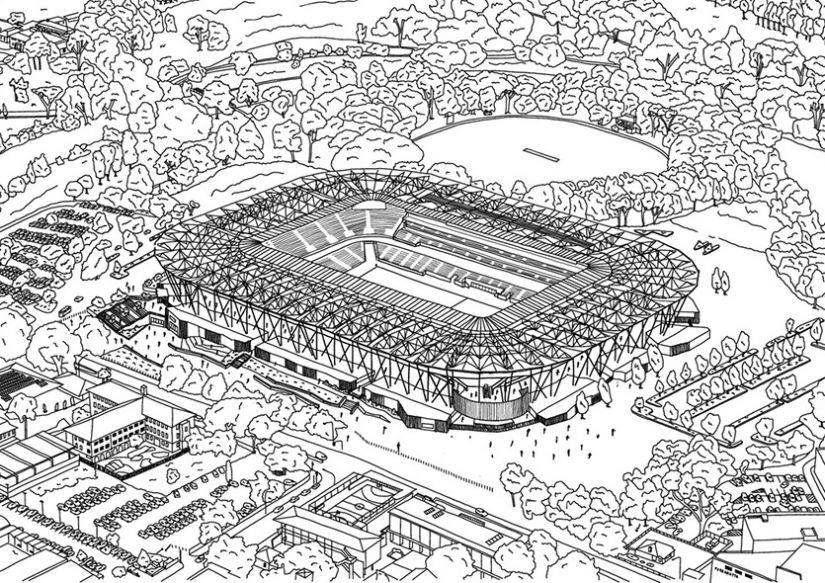
Zoe Engeman, 3 July, 2024 | CommBank Stadium sketched by Populous Architect Nick Fitzgerald.
Populous Sustainability Design Lead, Dr Kavita Gonsalves shares her inspiring journey from a teenage athlete to a leading figure in sustainable sports architecture. Discover how her passion for the Olympics and sustainable design has shaped her career, and learn about the innovative principles she integrates into her projects.
What initially inspired you to pursue careers in architecture and design with a focus on sports venues?
As a teenage athlete, I loved the Olympics as a celebration of human excellence. I like to think that my career in sustainable precinct design and sports architecture happened by pure magic. It could be attributed to my work with sustainable architecture, design research, and placemaking (my PhD at QUT), but there is an element of timing, luck, chance, and dance. It is reflective of my career, which is a series of high-risk moves and happy accidents, including the decision to pursue architecture.
Sustainability is a crucial aspect of modern architecture. How do you integrate sustainable design principles into your work?
One could argue that modernity is the cause of the climate crisis thanks to a full cycle of voracious extraction and consumption. I posit that Sustainable Architecture is thus radical architecture—an architecture that is in service to place and community…how it used to be. With the architecture and construction industry responsible for nearly 40% of global carbon emissions, the resultant climate crisis is socially inequitable. The potential of architecture lies in its ability to demonstrate decarbonisation, community resiliency, enhancing biodiversity and improved social equity. The design principles that reflect these aspirations are always a conversation at the start of our design process with the ability to flow on through all design stages.

Can you share some innovative design elements you've implemented in sports venues and how they improve the overall experience?
Populous project CommBank Stadium, built in 2019, was designed and built for quick build and eventual deconstruction. We are beginning to utilise these principles across our other projects where we consider reuse of existing materials and venues, use of low-carbon materials and designing for disassembly. When I think of experience, I am interested in the collective experience of the human and the more-than-human. When circularity is practised in its truest essence, it brings out this balance and harmony within and between ecosystems because it eliminates virgin material extraction, and there is an opportunity to expend human creativity towards meaningful connections with nature.
What motivated your decision to pursue post-graduate study, and how has it impacted your career?
With over 15 years of experience spanning residential, commercial, and institutional architecture, design competitions, sustainability consulting, commercial research, real estate strategy, F&B design, retail design, workplace design, and community and stakeholder engagement, pursuing a PhD provided a unique opportunity to explore bold ideas, allow theory to emerge from my architectural and design practice and participatory action research, and continue fostering creativity and reflection.
An unexpected yet profound outcome of this journey was the articulation of my perspective and positionality, which, in turn, brings criticality to the wide-ranging conversations on how "sustainability" should be defined and designed.
How important is feedback from athletes and fans in your design process?
So important! It’s not just feedback from athletes and fans that I am interested in, but also local groups and First Nations communities. In my opinion, if our work is about bringing people together, then it starts with bringing them into the design process.
How do you envision the future of sports venue design?
There are so many visions of the future of sports venue design but I’ll present just one for our context. After you have grabbed a meal with your friends, you walk under the solar-powered shade canopies to the stadium for the game. This is no ordinary stadium: it has been built out of materials found in demolition sites and facilities that have reached the end of life. You can see the blots and the connections and know that the simplicity of construction allows anyone to dismantle it. What you do not know is that the stadium has a digital twin supported with blockchain technology which is in keeping with the government’s circularity and provenance policy. The stadium’s PV roof powers the stadium as well as the precinct. As you move closer to the stadium, you grab bush tucker for a quick feed from the trees and shrubs that are the external façade and assist in maintaining indoor thermal comfort. The concourse is a vibrant market where local farmers come and bring their produce along with food and beverages. During rain events, the stadium becomes a reservoir which is a transformed place: you can hang out on the steps with your buddies for just a conversation. You see families with buggies and strollers sitting where they please because of the flexible seat design… let your imagination complete this vision.
Lastly, do you have a favourite project you’ve worked on, and if so, what made it stand out to you?
The Living Bridges in Meghalaya, India, is a manifestation of what it means to negotiate with and revere the more-than-human Ficus Elastica. The day I can emulate that kind of ingenuity and creativity would be the day I find my favourite project.
Dr Kavita Gonsalves
QUT degree - PhD, Urban Informatics (2023)
Have a question for Kavita? Connect with her on LinkedIn.
